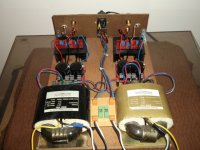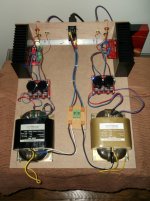Hi Mailard, the optional Ci cap does not increase bass, it will actually reduce it at lower frequencies, if it is too small in value the rolloff will start too early potentially lowering bass output.
It is used for protection purposes, As a capacitor will not pass DC it will cause the amplifier to have unity gain at DC therefore if you have say 20mv DC on the input it will give 20mV dc on the output. Without Ci if you have 20mV dc on the input you will get 640mV dc on the output (the gain of this amp is around 32 times).
As you don't have a coupling cap on the input, this is a big concern, you must only connect components that you know to have very low dc on their output.
However we can discount Ci as being the source of your lack of bass.
Tony.
It is used for protection purposes, As a capacitor will not pass DC it will cause the amplifier to have unity gain at DC therefore if you have say 20mv DC on the input it will give 20mV dc on the output. Without Ci if you have 20mV dc on the input you will get 640mV dc on the output (the gain of this amp is around 32 times).
As you don't have a coupling cap on the input, this is a big concern, you must only connect components that you know to have very low dc on their output.
However we can discount Ci as being the source of your lack of bass.
Tony.
I was about to upgrade the caps of the PSU to Munsdorf 15000 microF/18mohm instead of the Panasonic 10000 microF/36mhom.
While the Panasonics are definitely not my favourite caps, they do not appear bass-shy. As for the 3886, opinions vary. I have heard tolerable bass using very sympathetic speakers but with others bass has been clearly lacking. Not at all sure if any changes in the components will have sufficiently big effect. Paralleling may. Getting less bass than an anemic 3020 is indeed disheartening.
Hello,
Since the last post, I have used larger heatsinks. The result is significantly better, the sound being now well balanced.
Thank You for the help .
.
I'd like to experiment two modifications to see if I can obtain more :
1) 20000 µF / rails,
2) 10000 µF / rails + LM338 regulated PSU
What do You think ?
Bye.
Since the last post, I have used larger heatsinks. The result is significantly better, the sound being now well balanced.
Thank You for the help
I'd like to experiment two modifications to see if I can obtain more :
1) 20000 µF / rails,
2) 10000 µF / rails + LM338 regulated PSU
What do You think ?
Bye.
Attachments
What size bypass caps do you have directly across the chipamps' power pins? You might try experimenting with the sizes and types of those, especially with some electrolytics. They act as a point-of-load power supply that doesn't have the inductance of the supply rail conductors to slow down the response to the chip's need for changes in the current drawn, and to generate rail voltage dips and spikes when a chip's current draw tries to change.
I see that you haven't twisted together the wire pairs. You might have all types of strange things going on, in that case. Twist every pair of wires tightly together. Also add some RF filtering (even just 220 pF directly across the + and - signal input pins of each chip).
I see that you haven't twisted together the wire pairs. You might have all types of strange things going on, in that case. Twist every pair of wires tightly together. Also add some RF filtering (even just 220 pF directly across the + and - signal input pins of each chip).
One more suggestion
According to the ChipAmp instructions, your secondaries of 24V with +/-35VDC are at the upper limit of the ideal rail voltage for 8 ohm speakers, and above voltage recommended for lower impedance speakers. This is consistent with your finding that increasing heatsinks improved the sound. I very recently finished the same kit, only I'm using a single power supply. I also did not get creative, but did everything according the the instructions (I opted for Ci) but I'm only using 2X18v secondaries, and I'm getting excellent bass from 4 ohm speakers.
It's probably not worth the effort because you seem to have solved your problem, but with other projects consider lower rail voltages with this chip.
The transfos are 2X24v AC which gives +/- 35 V DC. After one hour, the heatsinks became a little hot (I will says 40 °C max).
According to the ChipAmp instructions, your secondaries of 24V with +/-35VDC are at the upper limit of the ideal rail voltage for 8 ohm speakers, and above voltage recommended for lower impedance speakers. This is consistent with your finding that increasing heatsinks improved the sound. I very recently finished the same kit, only I'm using a single power supply. I also did not get creative, but did everything according the the instructions (I opted for Ci) but I'm only using 2X18v secondaries, and I'm getting excellent bass from 4 ohm speakers.
It's probably not worth the effort because you seem to have solved your problem, but with other projects consider lower rail voltages with this chip.
Spike and some of the other protections built into the National chipamps are designed to vary their limits depending on chip temperature.
Increasing the dissipation capability of the assembly will reduce on chip temperature and could lead to less intrusive limiting.
This may give the impression of less treble content which your brain interprets as more bass in the balance.
I wonder if conjecture has any basis in the science?
I run my chipamps cool and follow my own advice to using double the dissipation that National recommend as the minimum.
I find that the 3886 plays adequately well using 88dB 8ohm speakers at background and average levels.
The sound deteriorates rapidly as SPLs are increased above average. I suspect the cool running Spike and protections are limiting the transients creating this horrible louder noise.
Increasing the dissipation capability of the assembly will reduce on chip temperature and could lead to less intrusive limiting.
This may give the impression of less treble content which your brain interprets as more bass in the balance.
I wonder if conjecture has any basis in the science?
I run my chipamps cool and follow my own advice to using double the dissipation that National recommend as the minimum.
I find that the 3886 plays adequately well using 88dB 8ohm speakers at background and average levels.
The sound deteriorates rapidly as SPLs are increased above average. I suspect the cool running Spike and protections are limiting the transients creating this horrible louder noise.
Last edited:
Hello Gootee,
I have 100 µF panasonic FC + 100nF MKP Wima. (values of the kit)
I can easily make a try with 100 µF more of the same type.
For the RF filtering, you mean 220pf in parallel with the (100µF + 100nF) ?
Thank You.
Actually, no. I meant that the 220pF (or whatever value is used) should be connected between the two audio signal input pins.
What size bypass caps do you have directly across the chipamps' power pins? You might try experimenting with the sizes and types of those, especially with some electrolytics. They act as a point-of-load power supply that doesn't have the inductance of the supply rail conductors to slow down the response to the chip's need for changes in the current drawn, and to generate rail voltage dips and spikes when a chip's current draw tries to change.
I see that you haven't twisted together the wire pairs. You might have all types of strange things going on, in that case. Twist every pair of wires tightly together. Also add some RF filtering (even just 220 pF directly across the + and - signal input pins of each chip).
Good news, I've made a try with 100µF more on each bypass caps and the result is very good, especially I have now a very pleasant sound stage effect with some good recordings.
end of the story
Hi,
I dig out this thread at the point where I left it 2 years ago:
- I changed the 2x100 µF Panasonic by a single 330 µF "Black Gate", the result was more detailled mids and trebles, but bass had disappeared .....,
- so I tried 2x100µF + 330µF and I finally got the fine sound of the BG and the strong bass of the Panasonics.
I still was not completly satisfied, but the sound was good enough for I decide to build a box for that amplifier.
After the box was built, I stopped working on the amp for a long time.
Four months ago I decided to try other changes. I have made a new PSU, very simple P2P, with 2x15000 µF on each rails.
After a few Hours (20) of operation, I just could not believe my ear: a fantastic overall upgrade ! Open sound, Mid, Bass, soundstage, everything was significantly better. I am discovering all my Cds...
The most important points of that built were (8 ohm speakers):
- double mono Brian GT kit with :
- 300 VA tranfo 2x24 V AC,
-2 x 15000 µF / rail (first try with 10000 µF /rail),
- 2x530 µF / rail on board (first try with 100µF / rail),
- 1°/W heatsink.
Some photos are available here:
http://www.diyaudio.com/forums/chip-amps/79303-chip-amp-photo-gallery-237.html#post3371038
Bye.
Hi,
I dig out this thread at the point where I left it 2 years ago:
- I changed the 2x100 µF Panasonic by a single 330 µF "Black Gate", the result was more detailled mids and trebles, but bass had disappeared .....,
- so I tried 2x100µF + 330µF and I finally got the fine sound of the BG and the strong bass of the Panasonics.
I still was not completly satisfied, but the sound was good enough for I decide to build a box for that amplifier.
After the box was built, I stopped working on the amp for a long time.
Four months ago I decided to try other changes. I have made a new PSU, very simple P2P, with 2x15000 µF on each rails.
After a few Hours (20) of operation, I just could not believe my ear: a fantastic overall upgrade ! Open sound, Mid, Bass, soundstage, everything was significantly better. I am discovering all my Cds...
The most important points of that built were (8 ohm speakers):
- double mono Brian GT kit with :
- 300 VA tranfo 2x24 V AC,
-2 x 15000 µF / rail (first try with 10000 µF /rail),
- 2x530 µF / rail on board (first try with 100µF / rail),
- 1°/W heatsink.
Some photos are available here:
http://www.diyaudio.com/forums/chip-amps/79303-chip-amp-photo-gallery-237.html#post3371038
Bye.
Last edited:
- Status
- This old topic is closed. If you want to reopen this topic, contact a moderator using the "Report Post" button.
- Home
- Amplifiers
- Chip Amps
- Lack of bass with LM3886

